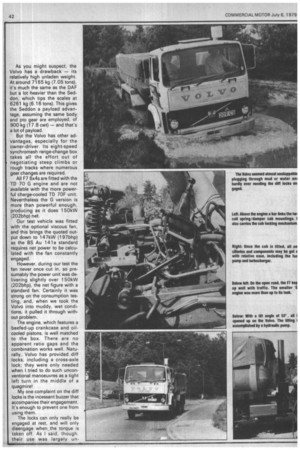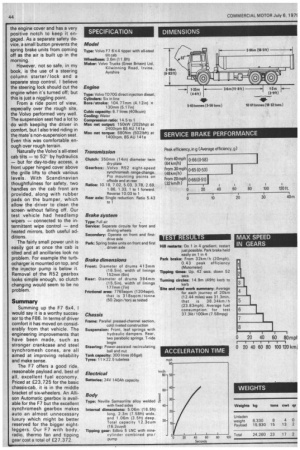Volvo sets high tipper standard
Page 43

Page 44

Page 45

Page 46

If you've noticed an error in this article please click here to report it so we can fix it.
The tipper version of Volvo's F7 range is no ligh-weight but it offers a good:package for owners, reports Steve Gray, Pictures by Dick Ross
VOL O'S F7 RANGE has made a bi impact on the UK market sinc its launch just before the NES show at Birmingham last yea Taking over in a big way fro the superseded F86, total sal -s since October have reac ed 1,700.
ost of these are tractive unit, but eight-wheelers, too, hay done very well. Now the sixheelers are beginning to take off, and from our recent roa test of this latter model, in 6x4 tipper guise, it's easy to see wh F r a start, the Volvo proved to exceptionally economical ove our tough and taxing tipper rout-, It includes not only A and B r ad running, but a rugged offoad section which really brin s down the consumption.
ut the Volvo F7 dealt with it co fortably and brought in a hea thy 37.3 litre/100km (7. 8 mpg) at an average speed for each of the ten runs of 38. 4km/h (23.83mph). It's diffi ult to put this properly into per pective, as so far we have onl carried out three tipper test and just two of these were sixheelers, till, the Volvo comes out far and away the winner of the three sixheelers. For example, it bra ght in nearly one mile per gallon more than the Seddon Atkinson 300, which produced an average 42.7 lit/100km (6.6 mpg) and was virtually 1.4 mpg up on DAF's FTA 2305 six-legger, Neither of these were thought to be bad consumption figures, so clearly the Volvo's must be an excellent figure by comparison.
Nor was the Volvo a slouch round the circuit. Indeed its average speed of 38.34 km/ h (23.83 mph) was faster than both the DAF and the Seddon, which curiously averaged the same 37,6 km/h (23.4 mph). It was faster, too, than the DAF 2305 DHU 8x4 tipper.
But the fuel returns are its most impressive feature. In real terms it means a saving, over our route, of 11.1 litres (2.44 gal) compared to the Seddon, and 16.73 litres (3.68 gal) against the DAF per day. With dery costing upwards of £1.10 per gal, it's a lot of money per year — around -£1000 between the Volvo and the DAF. As you might suspect, the Volvo has a drawback — its relatively high unladen weight. At around 7165 kg (7.05 tons), its much the same as the DAF but a lot heavier than the Seddon, which tips the scales at 6261 kg (6.16 tons). This gives the Seddon a payload advantage, assuming the same body and pto gear are employed, of 900 kg (17.8 cwt) — and that's a lot of payload.
But the Volvo has other advantages, especially for the owner-driver. Its eight-speed synchromesh range-change box takes all the effort out of negotiating steep climbs or rough tracks where numerous gear changes are required.
All F7 6x4s are fitted with the TD 70 G engine and are not available with the more powerful charge-cooled TD 70F unit. Nevertheless the G version is more than powerful enough, producing as it does 150kW (202bhp) net.
Our test vehicle was fitted with the optional viscous fan, and this brings the quoted output down to 147kW (197bhp) as the BS Au 141a standard requires net power to be calculated with the fan constantly engaged.
However, during our test the fan never once .cut in, so presumably the power unit was delivering slightly over 150kW (202bhp), the net figure with a standard fan. Certainty it was strong on the consumption testing, and, when we took the Volvo into muddy, wet conditions, it pulled it through without problem.
The engine, which features a beefed-up crankcase and oilcooled pistons, is well matched to the box. There are no apparent ratio gaps and the combination works well. Naturally, Volvo has provided diff locks, including a cross-axle lock; they were only needed when I tried to do such unconventional manoeuvres as a tight left turn in the middle of a quagmire!
My one complaint on the diff locks is the incessant buzzer that accompanies their engagement. It's enough to prevent one from using them.
The locks can only really be engaged at rest, and will only disengage when, the torque is taken off. As I said, though, their use was largely un necessary as the Volvo, in spite of road-going tyres, could handle the conditions without difficulty.
If the fuel consumption of the Volvo is one of its strongest points, then the cab must be the next. The old F86 was applauded for its driver comfort and the F7 has taken it one step further.
Although it's higher than its predecessor, entry to the cab is first-class, with sturdy grabhandles and well positioned steps. These latter are of the steel grille type to provide a good grip even for welly-booted feet. My one misgiving about the higher cab, though, concerns the air intake box which looks rather vulnerable to flying debris in this tipper application. Its a spindly-looking affair and I'd have thought could be better placed.
Once inside the cab the tipper driver is cosseted in the sort of luxury reserved for long-haul vehicles — after all, the same trim is used for tractive units too. Although the floor on both the driver's and mate's sides is covered with rubber mats, the engine cover is carpeted.
Nylon trim is used for the roof lining and for the cab back, but I wonder how long its pleasant appearance would last in service. Volvo tells me that there may be a rubber cover available for the engine hump, which would be an advantage. Nevertheless it's a sign of the times that tipper drivers are being looked after, too.
In true Volvo fashion, the instrumentation and controls are placed sensibly and for the most part are easy to reach. A variation on the ISO standard of switch layout is employed around the Volvo's steering column. The indicators are on the left, below the wiper control, and this latter switch operates three wiper blades, on either intermittent or one of two speeds.
A particularly neat feature is the use of washers built into the wipers. This permits a good soaking of the screen in exactly the right area. Unlike the normal ISO set up, Volvo fits a separate light switch to the right of the driver on the dash. A bank of warning lights — some with arcane symbols — are arranged across the top of the instrument binnacle. None of these is obscured by the steering wheel rim and they are checked automatically when the ignition is turned on.
A deep well in the centre of the dash gives the driver somewhere to put delivery dockets and weight tickets. A lockable bin is located next to this in front of the mate's seat to provide a home for more valuable items.
found the gear lever, with its neat toggle switch for rangechanging, was placed just right for me. However, I would have been happier if I could have got the suspension seat lower so that I could see more through the lower half of the screen. It didn't present any problems, though, and generally forward visibility is good.
The spacing between the throttle and brake pedal is good and again boots can be worn without any overlapping. I didn't particularly like the location of the Edbro tipping controls. It's their combined pto unit, but Volvo tells me it can fit a tumbler switch on the dash for pto engagement.
Like the F86, the park brake lever on the -F7 is mounted on
the engine cover and has a very positive notch to keep it engaged. As a separate safety device, a small button prevents the spring brake units from coming off as the air is built up in the morning.
However, not so safe, in my book, is the use of a steering column starter/lock and a separate stop control. I believe the steering lock should cut the engine when it's turned off; but this is just a niggling point.
From a ride point of view, especially over the rough site, the Volvo performed very well. The suspension seat had a lot to do with keeping the driver in comfort, but I also tried riding in the mate's non-suspension seat. Even this was comfortable enough over rough terrain.
Naturally the Volvo's all-steel cab tilts — to 52 by hydraulics — but for day-to-day access, a front upper hinged cover above the grille lifts to check various levels. With Scandinavian thoughtfulness for safety, two handles on the cab front are provided, along with rubber pads on the bumper, which allow the driver to clean the screen without falling off. Our test vehicle had headlamp wipers — connected to the intermittent wipe control — and heated mirrors, both useful additions.
The fairly small power unit is easily got at once the cab is tilted and all ancillaries look no problem. For example the turbocharger is mounted on top, and the injector pump is below it. Removal of the R52 gearbox looks simple enough, so clutch changing would seem to be no problem.
Summary Summing up the F7 6x4, I would say it is a worthy successor to the F86. In terms of driver comfort it has moved on considerably from that vehicle. The engineering improvements that have been made, such as stronger crankcase and steel synchromesh cones, are all aimed at improving reliability and make sense.
The F7 offers a good ride, reasonable payload and, best of all, excellent fuel economy. Priced at E23, 7 25 for the basic chassis-cab, it is in the middle bracket of six-wheelers. An Allison Automatic gearbox is available for the F7 but the excellent synchromesh gearbox makes auto an almost unnecessary luxury which might be better reserved for the bigger eightleggers, Our F7 with body, radio, therm° fan and tipping gear cost a total of £27, 3 72




























































































































